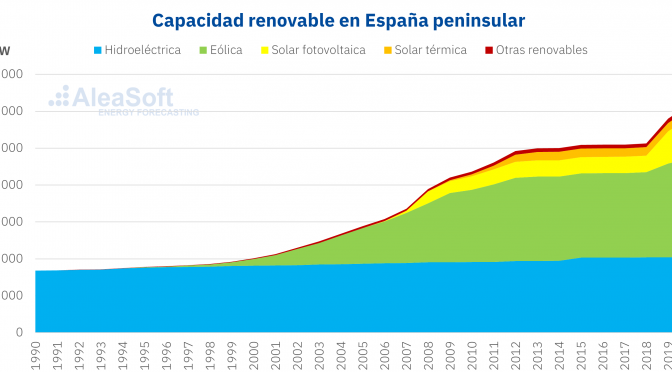After some time, Spain has returned to the world top ten in terms of renewable capacity. But looking at the numbers in detail, its position in the ranking improves if each particular renewable technology is analyzed individually.
Spain is, without a doubt, one of the great world powers in terms of installed power from renewable energy sources. Taking into account that it is not a particularly extensive territory or with a large population, it has a special merit. But how does MW compare to MW with the rest of the large economies that have opted for renewables?
Renewable capacity in Spain
The numbers alone are already quite spectacular. According to data from Red Eléctrica de España (REE) at the end of December 2020, the peninsular territory had 26,811 MW of wind power and 11,277 MW of photovoltaic power. Adding the rest of renewable technologies, the total peninsular renewable capacity amounted to 61,994 MW.
Looking at the national global, which includes the extra-peninsular territories, the installed wind power reaches 27,259 MW and the photovoltaic, 11,547 MW. The national total of renewable capacity remains at 62,768 MW.
Comparison with European countries
At the level of the European Union, with data from Eurostat for 2019, Spain is at least among the first four places in the entire European Union in terms of installed renewable capacity for both hydroelectric, wind and solar.
It is the third country in installed hydroelectric capacity behind France and Italy. It is the second in installed wind capacity behind, and far behind, Germany and behind, in third place, is the United Kingdom on its heels. Regarding solar power, including both photovoltaic and solar thermal power, it is in the fourth position in the European ranking.
World comparison
In the world ranking of renewable energy capacity, Spain is in the top ten, right in the tenth position, according to IRENA data from 2019. But looking technology by technology, the situation is much better in some cases.
According to REN21 data from 2019, Spain is the tenth world power in installed photovoltaic capacity. A ranking that will surely improve significantly in the coming years as the PNIEC targets for 2030 are progressed. The ranking of wind capacity worldwide improves to fifth for Spain. And looking at the solar thermal capacity, Spain is in the number one place as a world power of this technology.
Spain, world laboratory for renewables
As has been seen, Spain is already in a good position to achieve the ambitious objectives of the PNIEC. This good starting position and the good pace that the new renewable capacity installed in 2020 has begun to set is turning Spain into the world laboratory for renewables and has put it in the spotlight of international investors.
To focus global attention, the results of the renewable auction held at the end of January have helped. The results of the auction are very good for investors. Even though they are low prices, they are not ridiculously low prices, they are reasonably low prices. These are prices that make investments in new renewable facilities profitable in the long term, taking into account that after being subjected to the Renewable Energy Economic Regime (REER) the plants will continue operating.
In addition, with the necessary investments, Spain has the opportunity to become the main hub for the production and export of green hydrogen in the south of the continent thanks to the renewable resource, mainly solar, at its disposal.
The cycle of webinars “Perspectives of energy markets in Europe from 2021” is being carried out at AleaSoft with the participation of speakers from the most important companies in the energy sector on the continent. The third part of this series is scheduled for February 18, and this time it will have the collaboration of ENGIE, to analyze the prospects of the energy markets and the financing of renewable energy projects as of this 2021. Later, the fourth part of the webinar series is scheduled for March 18 and will feature the collaboration of speakers from EY (Ernst & Young).
After the first workshop organized by AleaSoft on February 4, where the AleaApp platform functionalities for the compilation, visualization and analysis of data related to energy markets were shown, the next workshop will be held on February 11 and will show the agents operating in the electricity spot and futures markets how to make the most of medium-term market price forecasts and stochasticity.
AleaSoft also has a wide variety of reports for the energy sector that cover the main markets in Europe. In addition, new complementary services associated with long-term price curve reports are also offered to advise on their use.


